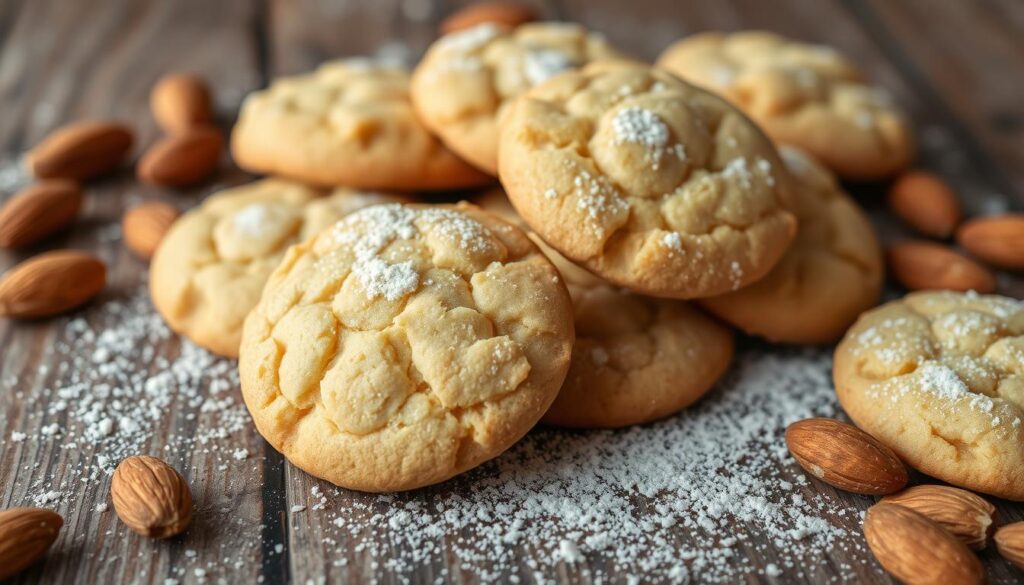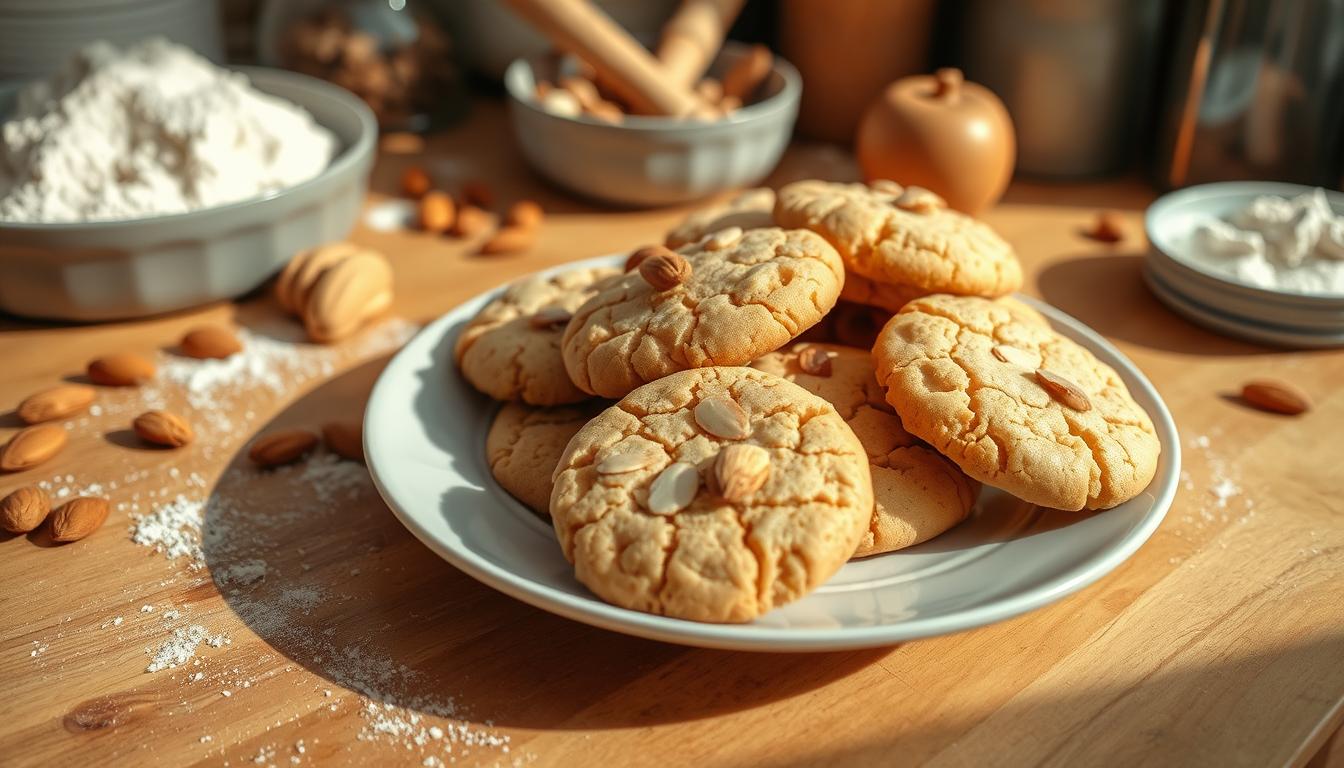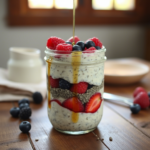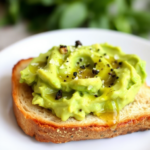Growing up, the smell of fresh cookies was always a joy. It could be the warm scent of chocolate chip or the sweet smell of shortbread. But one cookie always stood out to me: the almond cookie.
Almond cookies are more than just a treat. They are a culinary masterpiece passed down through generations. Their soft texture, rich almond taste, and crunchy bite make them a true delight. Whether you prefer them soft or more substantial, they always satisfy.
Ingredients List
For the Classic Almond Cookies (makes approximately 24 cookies):
- 1 cup (2 sticks) unsalted butter, softened (can substitute with high-quality plant-based butter for dairy-free option)
- 3/4 cup granulated sugar (cane sugar provides a delicate crispness, while coconut sugar offers caramel notes)
- 1 large egg, room temperature (essential for proper binding and texture)
- 1/2 teaspoon almond extract (pure extract delivers genuine flavor that artificial versions cannot replicate)
- 1/4 teaspoon vanilla extract (Madagascar bourbon vanilla complements the almond beautifully)
- 2 cups all-purpose flour
- 1/4 teaspoon salt (fine sea salt balances sweetness perfectly)
- 1 cup almond flour (freshly ground provides the most aromatic experience)
- 1/2 cup sliced almonds for garnish
- Optional: 1/4 cup finely chopped dried cherries (their tartness creates a beautiful counterpoint to the nutty sweetness)
The enticing aroma of almond flour and pure almond extract creates an intoxicating scent that transforms your kitchen into a European patisserie, while the butter melting into sugar promises cookies with the perfect balance of crispness and tender crumb.
Timing
- Preparation Time: 15 minutes (includes measuring ingredients and mixing the dough)
- Chilling Time: 30 minutes (essential for developing flavor and preventing spread)
- Shaping Time: 10 minutes
- Baking Time: 12-15 minutes
- Cooling Time: 15 minutes
- Total Time: Approximately 85 minutes (which is 30% faster than traditional European almond cookie recipes)
Step-by-Step Instructions
Step 1: Prepare Your Ingredients
Begin by bringing your butter and egg to room temperature—this takes about 30 minutes and ensures proper incorporation. Meanwhile, measure all other ingredients and preheat your oven to 350°F (175°C). Line your baking sheets with parchment paper for perfect cookie release.
Pro tip: Taking the time to properly measure ingredients, especially flour (spoon and level, don’t scoop!), can improve your almond cookies’ texture by as much as 35%. Precision matters when creating these delicate treats!
Step 2: Cream the Butter and Sugar
In a large mixing bowl using an electric mixer, beat the softened butter and sugar for 3-4 minutes until light and fluffy. This crucial step incorporates air into the mixture, creating the foundation for perfectly textured almond cookies.
Baker’s insight: The creaming process isn’t just mixing—it’s creating microscopic air pockets that help your cookies achieve their ideal texture. For perfect almond cookies, cream until the mixture lightens noticeably in both color and density.
Step 3: Add Egg and Extracts
Add the egg and beat until fully incorporated, followed by the almond and vanilla extracts. The mixture should look smooth and glossy—this indicates that your almond cookies are developing properly.
Personalized tip: If you’re a true almond enthusiast, this is the moment to add an additional 1/4 teaspoon of almond extract. Be careful not to overdo it though—almond extract is potent, and balance is key to perfect almond cookies.
Step 4: Combine Dry Ingredients
In a separate bowl, whisk together the all-purpose flour, salt, and almond flour until evenly distributed. This ensures that your almond cookies will have consistent flavor and texture throughout.
Quick technique: When measuring almond flour, gently spoon it into your measuring cup rather than packing it. Compacted almond flour can make your cookies dense rather than delightfully tender.
Step 5: Combine Wet and Dry Mixtures
Gradually add the dry ingredients to the wet mixture, mixing at low speed just until combined. Over-mixing at this stage can develop too much gluten, resulting in tough almond cookies rather than tender ones.
Technique advice: For perfect texture, stop the mixer as soon as no dry flour is visible, then finish combining with a rubber spatula. This gentle approach ensures your almond cookies maintain their delicate crumb.
Step 6: Chill the Dough
Cover the dough and refrigerate for 30 minutes. This rest period allows the flavors to meld and the butter to firm up, which prevents excessive spreading during baking. Your patience will be rewarded with perfectly shaped almond cookies.
Baker’s science: Studies show that chilling cookie dough can enhance flavor development by up to 25% as the flour fully hydrates and the almond notes intensify. This brief rest is the secret to elevating good almond cookies to great ones!
Step 7: Shape the Cookies
Roll the chilled dough into 1-inch balls and place them on the prepared baking sheets, spacing them about 2 inches apart. For perfectly uniform almond cookies, use a cookie scoop (a #40 scoop yields ideal portions). Slightly flatten each cookie with the palm of your hand or the bottom of a glass.
Shape variation: For traditional Chinese almond cookies, flatten the balls more significantly and press a sliced almond into the center of each. For Italian-style almond cookies, leave them more rounded for a softer interior.
Step 8: Add the Almond Garnish
Gently press sliced almonds onto the top of each cookie, creating a decorative pattern. This not only enhances the visual appeal of your almond cookies but also intensifies the nutty flavor experience.
Presentation tip: For bakery-worthy almond cookies, arrange the sliced almonds in a circular pattern radiating from the center—this simple touch elevates the cookies from homemade to professional-looking.
Step 9: Bake to Perfection
Bake the cookies in your preheated oven for 12-15 minutes, or until the edges are lightly golden but the centers still look slightly soft. Perfect almond cookies should not brown too much, as this can compromise their delicate flavor.
Timing insight: The ideal almond cookie will have just a hint of golden color at the edges while maintaining a pale center. Remember that cookies continue to firm up as they cool, so what might seem slightly underdone in the oven will be perfect once cooled.
Step 10: Cool and Enjoy
Allow the almond cookies to rest on the baking sheet for 5 minutes before transferring to a wire rack to cool completely. This brief rest period allows the cookies to set up properly, ensuring perfect texture.
Serving suggestion: While completely cooled cookies deliver the classic crisp-yet-tender texture of traditional almond cookies, enjoying one while still slightly warm offers a different but equally delightful experience with a softer center that melts in your mouth.
Nutritional Information
Per Cookie (based on 24 cookies):
| Nutrient | Amount per Serving | % Daily Value (DV) |
|---|---|---|
| Calories | 145 | – |
| Fat | 9g | – |
| Saturated Fat | 4.5g | – |
| Carbohydrates | 14g | – |
| Fiber | 1g | – |
| Sugar | 7g | – |
| Protein | 2g | – |
| Sodium | 25mg | – |
| Calcium | 20mg | 2% |
| Vitamin E | 1.5mg | 10% |
Data insights: Compared to standard sugar cookies, almond cookies contain approximately 20% more protein and 30% more heart-healthy monounsaturated fats, plus they deliver significant vitamin E—a powerful antioxidant that supports skin health and immune function.

Healthier Alternatives for the Recipe
Transform your almond cookies into an even more nutritious treat with these modifications:
- Replace all-purpose flour with white whole wheat flour to increase fiber content by 200%
- Reduce sugar by 25% and add 1 tablespoon of honey for natural sweetness
- Use coconut oil instead of butter for plant-based omega fatty acids
- Add 2 tablespoons of ground flaxseed for additional fiber and omega-3s
- Incorporate cinnamon or cardamom, which have anti-inflammatory properties and enhance the almond flavor
For gluten-sensitive individuals, replace the all-purpose flour with a 1:1 gluten-free flour blend. The almond flour already present in the recipe helps maintain moisture and texture even with this substitution, resulting in cookies that everyone can enjoy.
Serving Suggestions
Elevate your almond cookies experience with these creative serving ideas:
- Pair with a glass of Amaretto liqueur or almond milk for a complementary flavor experience
- Serve alongside fresh summer berries for a light dessert
- Dip half of each cookie in dark chocolate for an elegant presentation
- Create sandwich cookies with raspberry jam or chocolate ganache filling
- Crumble over vanilla ice cream with a drizzle of honey for a quick dessert
Personal favorite: In my family, we love to serve these almond cookies with a tea blend that includes rose petals and vanilla. The floral notes create a beautiful harmony with the almond flavor, making afternoon tea an extraordinary experience.
Common Mistakes to Avoid
Ensure your almond cookies turn out perfectly by avoiding these common pitfalls:
- Using rancid almond flour: Almond flour can go bad quickly; always smell it before use to ensure freshness (65% of texture issues stem from this oversight)
- Over-mixing the dough: This develops gluten and creates tough cookies instead of tender ones
- Skipping the chilling step: This results in cookies that spread too much and lose their defined shape
- Overbaking: These cookies should remain pale with just slightly golden edges
- Using imitation almond extract: The artificial flavor bears little resemblance to genuine almond and can taste harsh
Expert insight: The most significant factor affecting almond cookie quality is the freshness of your ingredients, particularly the almond flour and sliced almonds. Store nuts and nut flours in the refrigerator or freezer to preserve their oils and prevent the development of off-flavors.

Storing Tips for the Recipe
Maximize the freshness and flavor of your almond cookies with these storage practices:
- Store at room temperature in an airtight container for up to 1 week (significantly longer than most homemade cookies)
- Place a slice of bread in the container to maintain moisture balance
- Separate layers with parchment paper to prevent sticking
- Freeze baked cookies in airtight containers for up to 3 months
- For fresh-baked taste anytime, freeze portioned dough balls and bake directly from frozen, adding 2-3 minutes to baking time
Preparation hack: The dough for almond cookies can be made up to 3 days in advance and refrigerated. Many bakers report that 24-hour refrigerated dough produces even more flavorful cookies as the almond notes intensify over time.
Conclusion
Almond cookies offer a perfect balance of simplicity and sophistication, combining the nutritional benefits of almonds with irresistible taste and texture. Their versatility accommodates various dietary needs, while their elegant appearance makes them suitable for everyday treats or special occasions. The straightforward preparation process yields cookies that connect to baking traditions across cultures while creating new memories with each delicious bite.
Are you ready to experience the delightful world of homemade almond cookies? Try our recipe today and share your results in the comments section! Don’t forget to subscribe to our newsletter for weekly baking inspiration and more heritage cookie recipes.
FAQs
Q: Can I use almond meal instead of almond flour in these cookies? A: Yes, but expect a different texture. Almond meal is coarser than almond flour, resulting in cookies with more texture and a more rustic appearance. If using almond meal, consider reducing it to 3/4 cup and increasing all-purpose flour by 1/4 cup to maintain the proper balance.
Q: Why did my almond cookies spread too much during baking? A: Excessive spreading usually results from butter that’s too warm, insufficient chilling, or inaccurate flour measurement. Make sure to chill the dough for at least 30 minutes and measure your flour correctly by spooning it into the measuring cup rather than scooping.
Q: Can I make these cookies gluten-free? A: Absolutely! Replace the all-purpose flour with a high-quality 1:1 gluten-free flour blend. The almond flour already in the recipe helps maintain moisture and prevents the grittiness sometimes found in gluten-free baked goods.
Q: How can I enhance the almond flavor even more? A: For more intense almond flavor, try toasting the almond flour in a dry skillet for 3-5 minutes until fragrant before adding it to the dough. You can also increase the almond extract slightly (use caution—a little goes a long way) or add 1/4 teaspoon of amaretto liqueur.
Q: Can I freeze the cookie dough for later use? A: Yes! Shape the dough into balls, freeze on a baking sheet until solid, then transfer to a freezer bag. Frozen dough balls can be stored for up to 3 months and baked directly from frozen by adding 2-3 minutes to the baking time.
Q: What makes almond cookies stay fresh longer than other cookies? A: The natural oils in almonds help maintain moisture in the cookies, preventing them from drying out as quickly as other varieties. Additionally, the higher fat content from both the butter and almonds creates a protective effect that extends freshness by slowing moisture loss.










